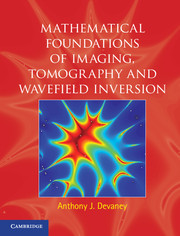Refine search
Actions for selected content:
6791 results in Communications and signal processing
18 - Covert underwater acoustic communications – coherent scheme
- from Part IV - Diverse application examples
-
- Book:
- Waveform Design for Active Sensing Systems
- Published online:
- 05 August 2012
- Print publication:
- 12 July 2012, pp 267-279
-
- Chapter
- Export citation
12 - Periodic ambiguity function (PAF)
- from Part II - Periodic correlation synthesis
-
- Book:
- Waveform Design for Active Sensing Systems
- Published online:
- 05 August 2012
- Print publication:
- 12 July 2012, pp 175-184
-
- Chapter
- Export citation
17 - Ultrasound system for hyperthermia treatment of breast cancer
- from Part IV - Diverse application examples
-
- Book:
- Waveform Design for Active Sensing Systems
- Published online:
- 05 August 2012
- Print publication:
- 12 July 2012, pp 259-266
-
- Chapter
- Export citation
Part I - Aperiodic correlation synthesis
-
- Book:
- Waveform Design for Active Sensing Systems
- Published online:
- 05 August 2012
- Print publication:
- 12 July 2012, pp 15-16
-
- Chapter
- Export citation
Preface
-
- Book:
- Waveform Design for Active Sensing Systems
- Published online:
- 05 August 2012
- Print publication:
- 12 July 2012, pp xi-xii
-
- Chapter
- Export citation
4 - Lower bounds for aperiodic sequences
- from Part I - Aperiodic correlation synthesis
-
- Book:
- Waveform Design for Active Sensing Systems
- Published online:
- 05 August 2012
- Print publication:
- 12 July 2012, pp 67-73
-
- Chapter
- Export citation
14 - Covariance matrix to waveform
- from Part III - Transmit beampattern synthesis
-
- Book:
- Waveform Design for Active Sensing Systems
- Published online:
- 05 August 2012
- Print publication:
- 12 July 2012, pp 213-221
-
- Chapter
- Export citation
Frontmatter
-
- Book:
- Waveform Design for Active Sensing Systems
- Published online:
- 05 August 2012
- Print publication:
- 12 July 2012, pp i-iv
-
- Chapter
- Export citation
13 - Narrowband beampattern to covariance matrix
- from Part III - Transmit beampattern synthesis
-
- Book:
- Waveform Design for Active Sensing Systems
- Published online:
- 05 August 2012
- Print publication:
- 12 July 2012, pp 187-212
-
- Chapter
- Export citation
2 - Single aperiodic sequence design
- from Part I - Aperiodic correlation synthesis
-
- Book:
- Waveform Design for Active Sensing Systems
- Published online:
- 05 August 2012
- Print publication:
- 12 July 2012, pp 17-38
-
- Chapter
- Export citation
References
-
- Book:
- Waveform Design for Active Sensing Systems
- Published online:
- 05 August 2012
- Print publication:
- 12 July 2012, pp 301-310
-
- Chapter
- Export citation
Index
-
- Book:
- Waveform Design for Active Sensing Systems
- Published online:
- 05 August 2012
- Print publication:
- 12 July 2012, pp 311-312
-
- Chapter
- Export citation
Abbreviations
-
- Book:
- Waveform Design for Active Sensing Systems
- Published online:
- 05 August 2012
- Print publication:
- 12 July 2012, pp xiv-xiv
-
- Chapter
- Export citation
9 - Single periodic sequence design
- from Part II - Periodic correlation synthesis
-
- Book:
- Waveform Design for Active Sensing Systems
- Published online:
- 05 August 2012
- Print publication:
- 12 July 2012, pp 149-157
-
- Chapter
- Export citation
3 - Aperiodic sequence set design
- from Part I - Aperiodic correlation synthesis
-
- Book:
- Waveform Design for Active Sensing Systems
- Published online:
- 05 August 2012
- Print publication:
- 12 July 2012, pp 39-66
-
- Chapter
- Export citation
5 - Stopband constraint case
- from Part I - Aperiodic correlation synthesis
-
- Book:
- Waveform Design for Active Sensing Systems
- Published online:
- 05 August 2012
- Print publication:
- 12 July 2012, pp 74-87
-
- Chapter
- Export citation
Part IV - Diverse application examples
-
- Book:
- Waveform Design for Active Sensing Systems
- Published online:
- 05 August 2012
- Print publication:
- 12 July 2012, pp 245-246
-
- Chapter
- Export citation
8 - Joint design of transmit sequence and receive filter
- from Part I - Aperiodic correlation synthesis
-
- Book:
- Waveform Design for Active Sensing Systems
- Published online:
- 05 August 2012
- Print publication:
- 12 July 2012, pp 123-146
-
- Chapter
- Export citation

Optimal Estimation of Parameters
-
- Published online:
- 05 July 2012
- Print publication:
- 07 June 2012

Mathematical Foundations of Imaging, Tomography and Wavefield Inversion
-
- Published online:
- 05 July 2012
- Print publication:
- 21 June 2012
